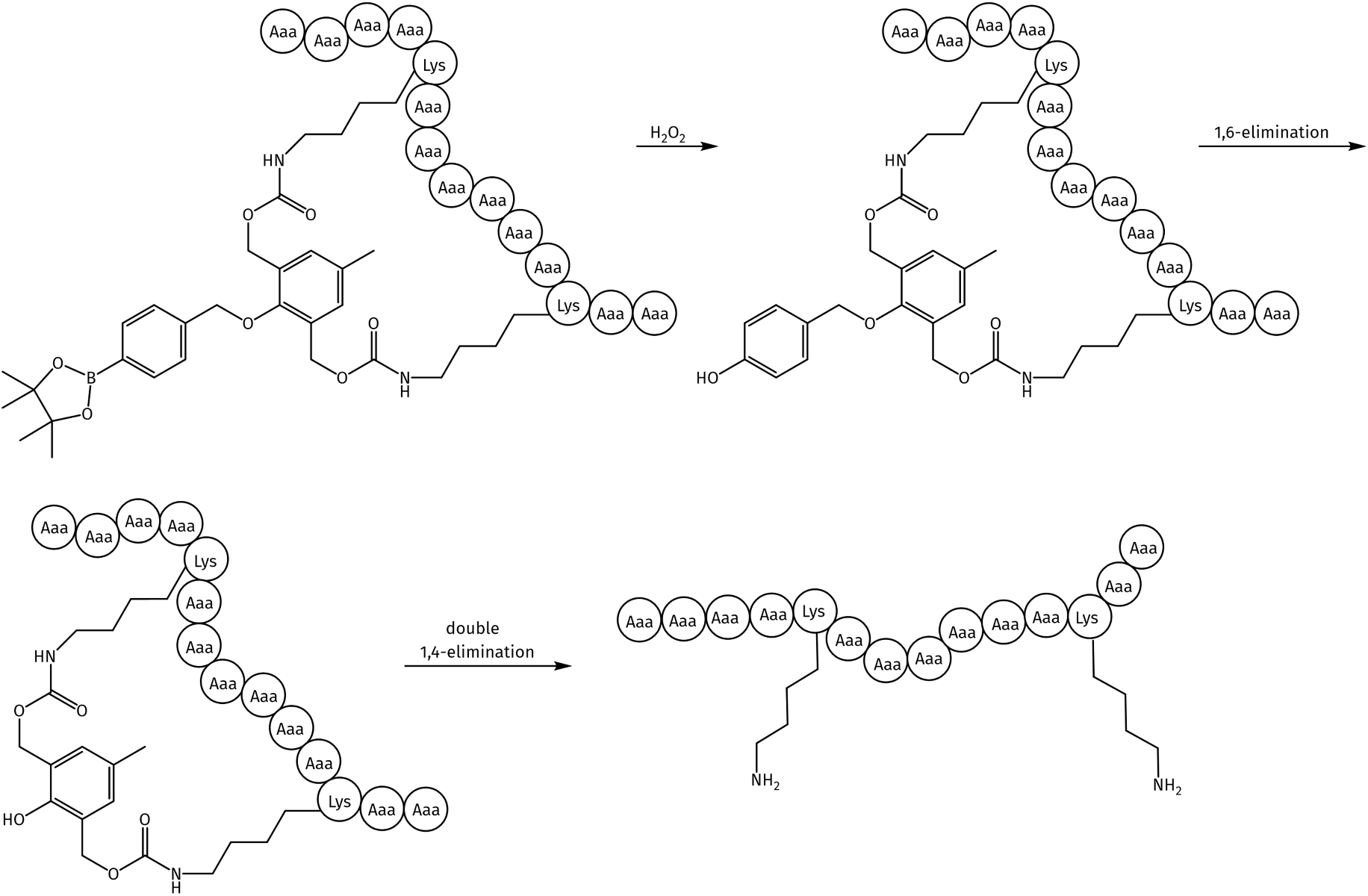Welcome to Iris Biotech
For better service please confirm your country and language we detected.

For better service please confirm your country and language we detected.

Thank you very much for your interest in our products. All prices listed on our website are ex-works, Germany, and may attract customs duties when imported.
You may/will be contacted by the shipping company for additional documentation that may be required by the US Customs for clearance.
We offer you the convenience of buying through a local partner, Peptide Solutions LLC who can import the shipment as well as prepay the customs duties and brokerage on your behalf and provide the convenience of a domestic sale.
Continue to Iris Biotech GmbHSend request to US distributorPublished on 07/02/2023

Drug therapeutics such as small molecules and peptides have high potential for the treatment of various diseases. However, most existing drugs pose serious threats to intact tissues due to their “always-on” pharmacological effect. To overcome this issue, prodrugs that only become cytotoxic in response to exogenous or endogenous stimuli, such as special disease markers, have been proposed.
An example for such a marker is hydrogen peroxide. As a relatively mild reactive oxygen species (ROS), H2O2 is recognized as a messenger molecule in various signaling processes. Additionally, in many enzymatic reactions, H2O2 is produced as a byproduct. However, excessive production of H2O2 is related to serious diseases including cardiovascular disorders, neurodegenerative diseases, inflammation, cancer, and diabetes.
Thus, on the one hand, the determination of changes in the H2O2 level, e.g. via fluorescent H2O2-probes, is a valuable tool for the detection of pathological conditions. On the other hand, the increased H2O2 level in malfunctioning cells can be used for triggered drug release in such compartments without harming properly functioning cells.
In the following, we present H2O2-sensitive self-immolative dioxoborolane linkers. Upon “detection” of hydrogen peroxide, the boronate protecting group is chemo-selectively converted to a phenol moiety followed by a 1,6-elimination reaction thus releasing the bound active species in a traceless manner. This reaction is thermodynamically driven by the release of CO2 when a carbonate or carbamate ester linkage is employed.
Such dioxoborolane linkers, e.g. RL-4130, are used for example for the preparation of masked H2O2 probes releasing their active fluorophore upon trigger detection. Another application is the generation of liposomes, which disrupt upon H2O2 detection and then release the active cargo.

Payload bound to dioxoborolane linker and traceless release upon reaction with hydrogen peroxide and 1,6-elimination.
The dioxoborolane motif is also provided as dendritic self-immolative linker (RL-4140) allowing to bind two payloads/reactive sites. In this case, the reaction of the dioxoborolane with H2O2 is followed by a 1,6-elimination and subsequent double 1,4-elimination leading to the release of the bound drugs.
This bifunctional linker can be used, e.g. for the reversible cyclization of peptides, for instance via reaction of both handles with two Lys-side chain amines. Peptides are biological macromolecules whose versatile functions are largely determined by their conformational structures. As mentioned in the beginning, they emerged as important class of therapeutics, but their broad use is often hampered by their low cell-membrane penetration, lack of specificity, and poor in vivo stability.
Cyclization of a peptide can lead to enhanced stability during circulation. Once inside the cell, the biologically active linear peptide can be released upon ring-opening via H2O2-triggered dual 1,4-elimination.

Schematic illustration of the self-immolation of a dendritic dioxoborolane linker.
➔ Looking for ways to stabilize your peptide?
Check out our flyers peptide modifiers and ß,ß-dimethyl amino acids or get in contact for further discussion!
Another linker suitable for reversible peptide cyclization is the azido-functionalized disulfide-based linker RL-4150. As the overall red/ox potential in the human blood is oxidative, disulfide linkages remain intact during circulation. However, intracellularly, and notably inside tumor mass and cancer cells, the reductive potential is prevailing.
As an example, the azide of the linker can be clicked to one position of the peptide and the nitrophenylcarbonate is reacted with another functional group leading to cyclization. Reductive cleavage of the disulfide bond, e.g. by glutathione (GSH), followed by self-immolation, leads to ring-opening and release of the linear peptide.
➔ You want more information about linker technologies? Download our brochure!
➔ You are interested in cyclic peptides and cyclization strategies? Download our booklet!
References:
Investigation of self-immolative linkers in the design of hydrogen peroxide activated metalloprotein inhibitors; J. L. Major Jourden, K. B. Daniel, S. M. Cohen; Chem. Commun. 2011; 47: 7968-7970. https://doi.org/10.1039/C1CC12526E
Reactive Oxygen Species-Responsive Protein Modification and Its Intracellular Delivery for Targeted Cancer Therapy; M. Wang, S. Sun, C. I. Neufeld, B. Perez-Ramirez, Q. Xu; Angew. Chem. Int. Ed. 2014; 53(49): 13444-13448. https://doi.org/10.1002/anie.201407234
Versatile Histochemical Approach to Detection of Hydrogen Peroxide in Cells and Tissues Based on Puromycin Staining; C. Yik-Sham Chung, G. A. Timblin, K. Saijo, C. J. Chang; J. Am. Chem. Soc. 2018; 140(19): 6109-6121. https://doi.org/10.1021/jacs.8b02279
Photoactivatable Organic Semiconducting Pro-nanoenzymes; J. Li, J. Huang, Y. Lyu, J. Huang, Y. Jiang, C. Xie, K. Pu; J. Am. Chem. Soc. 2019; 141(9): 4073-4079. https://doi.org/10.1021/jacs.8b13507
Reactive Oxygen Species-Responsive Liposomes via Boronate-Caged Phosphatidylethanolamine; J. Lou, M. D. Best; Bioconjugate Chem. 2020; 31(9): 2220-2230. https://doi.org/10.1021/acs.bioconjchem.0c00397
A mitochondrial-targetable dual functional near-infrared fluorescent probe to monitor pH and H2O2 in living cells and mice; X. Bi, Y. Wang, D. Wang, L. Liu, W. Zhu, J. Zhang, X. Zha; RSC Adv. 2020; 10: 26874-26879. https://doi.org/10.1039/D0RA03905E
A simple FRET-based modular design for diagnostic probes; O. Redy, E. Kisin-Finfer, E. Sella, D. Shabat; Org. Biomol. Chem. 2012; 10: 710-715. https://doi.org/10.1039/C1OB06667F
Chemically Reactive Supramolecular Hydrogel with a Signal Amplification System for Enhanced Analyte Sensitivity; T. Yoshii, S. Onogi, H. Shigemitsu, I. Hamachi; J. Am. Chem. Soc. 2015; 137(9): 3360-3365. https://doi.org/10.1021/ja5131534
Self immolative dioxetane based chemiluminescent probe for H2O2 detection; O. Seven, F. Sozmen, I. S. Turan; Sens. Actuators B 2017; 239: 1318-1324. https://doi.org/10.1016/j.snb.2016.09.120
>Influence of Linkers within Stimuli-Responsive Prodrugs on Cancer Therapy: A Case of Five Doxorubicin Dimer-Based Nanoparticles; Q. Wang, C. Wang, S. Li, Y. Xiong, H. Wang, Z. Li, J. Wan, X. Yang, Z. Li; Chem. Mater. 2022; 34(5): 2085-2097. https://doi.org/10.1021/acs.chemmater.1c03346
Customized Reversible Stapling for Selective Delivery of Bioactive Peptides; Z. Zeng, J. Zhu, X. Deng, H. Chen, Y. Jin, E. Miclet, V. Alezra, Y. Wan; J. Am. Chem. Soc. 2022; 144(51): 23614-23621. https://doi.org/10.1021/jacs.2c10949
Magnetic Resonance Imaging of PSMA-Positive Prostate Cancer by a Targeted and Activatable Gd(III) MR Contrast Agent; H. Li, D. Luo, C. Yuan, X. Wang, J. Wang, J. P. Basilion, T. J. Meade; J. Am. Chem. Soc. 2021; 143(41): 17097–17108. https://doi.org/10.1021/jacs.1c07377
Structure-Based Identification of Potent Lysine-Specific Demethylase 1 Inhibitor Peptides and Temporary Cyclization to Enhance Proteolytic Stability and Cell Growth-Inhibitory Activity; H. Kitagawa, M. Kikuchi, S. Sato, H. Watanabe, N. Umezawa, M. Kato, Y. Hisamatsu, T. Umehara, T. Higuchi; J. Med. Chem. 2021; 64(7): 3707-3719. https://doi.org/10.1021/acs.jmedchem.0c01371
Novel N-Methylated Cyclodepsipeptide Prodrugs for Targeted Cancer Therapy; C. Wu, Z. Cheng, D. Lu, K. Liu, Y. Cheng, P. Wang, Y. Zhou, M. Li, X. Shao, H. Li, W. Su, L. Fang; J. Med. Chem. 2021; 64(2): 991-1000. https://doi.org/10.1021/acs.jmedchem.0c01387
GSH Activated Biotin-tagged Near-Infrared Probe for Efficient Cancer Imaging; R. Guo, F. Huang, B. Zhang, Y. Yan, J. Che, Y. Jin, Y. Zhuang, R. Dong, Y. Li, B. Tan, R. Song, Y. Hu, X. Dong, X. Li, N. Lin; Theranostics 2019; 9(12): 3515-3525. https://doi.org/10.7150/thno.32742. https://www.thno.org/v09p3515.htm
Facile Fabrication of 10-Hydroxycamptothecin-Backboned Amphiphilic Polyprodrug with Precisely Tailored Drug Loading Content for Controlled Release; X. Zhang, M. Zhang, M. Wang, H. Peng, Q. Hua, L. Ma, B. Wang, H. Wei; Bioconjugate Chem. 2018; 29(7): 2239-2247. https://doi.org/10.1021/acs.bioconjchem.8b00238
Blurring the Role of Oligonucleotides: Spherical Nucleic Acids as a Drug Delivery Vehicle; X. Tan, X. Lu, F. Jia, X. Liu, Y. Sun, J. K. Logan, K. Zhang; J. Am. Chem. Soc. 2016; 138(34): 10834-10837. https://doi.org/10.1021/jacs.6b07554
pH and hydrogen peroxide dual responsive supramolecular prodrug system for controlled release of bioactive molecules; Y. Wang, H. Wang, Y. Chen, X. Liu, Q. Jin, J. Ji; Colloids and Surfaces B: Biointerfaces 2014; 121: 189-195. https://doi.org/10.1016/j.colsurfb.2014.06.024